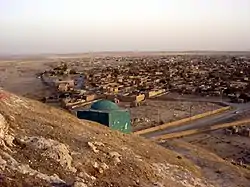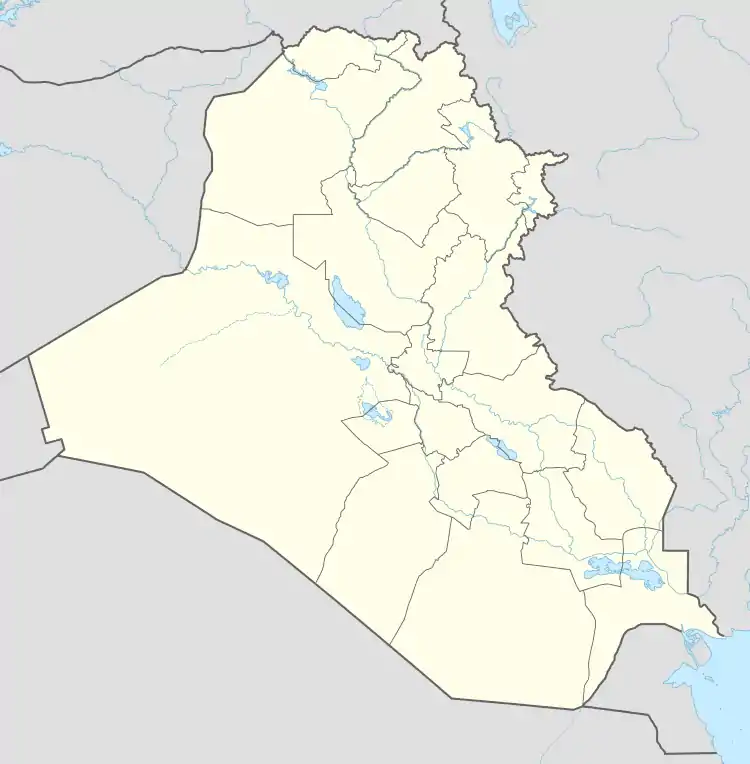Kifri
Kifri (Arabic: کفري;[2] Kurdish: کفری ,Kifrî;[3][4] Turkish: Kifri[5]) is the central town of Kifri District in Diyala Governorate, Iraq. It has a Kurdish majority and a Turkmen and Arab minority.[6][7] It is administered by Kurdistan Region but remains a disputed area.[8][9]
Kifri | |
|---|---|
Town | |
 View over Kifri | |
 Kifri Location in Iraq | |
| Coordinates: 34°41′0″N 44°58′0″E | |
| Country | |
| Governorate | Diyala Governorate |
| District | Kifri District |
| Elevation | 282 m (925 ft) |
| Population (2014)[1] | |
| • Total | 32,870 |
| Time zone | UTC+3 |
History
Kifri was known to have oil as early as the 1820s.[10] Kifri, which was also known as Salahiye during the Ottoman era,[11] was part of the Ottoman Empire until the United Kingdom captured the town in April 1918 during the Mesopotamian campaign.[12] During the capture, 565 Ottoman prisoners and one mountain gun were captured.[13] The local Kurds were supportive of the British and were described as very hostile to the Ottomans.[14] Britain briefly lost control over the town for two days during the revolt of 1920 to the local tribes. Captain G. H. Salmon was killed during the tribal takeover.[15]
The locals of Kifri did not support the Mahmud Barzanji revolts causing Mahmud Barzanji not to push for the inclusion of the town into his jurisdiction.[16] In 1921, the town was included in the plans of Winston Churchill in creating an independent Kurdistan which would work as a bulwark against Turkey.[17]
Under the British Mandate of Iraq, the Turkish language was an official language in Kifri under Article 5 of the Language Act of 1930, due to the town's significant Turkmen population.[18]
British data stated that Kurds constituted 67% and 60% of the population in the town in 1924 and 1931, respectively, while the remaining population was Arab and Turkmen.[7] However, the town was not included in the 1931 British-Iraqi 'Local Languages Law' initiative which would have made Kurdish an official language in the town for arbitrary reasons.[19] 70% of the population was Kurdish in the Iraqi census of 1947.[20]
Iraqi-Kurdish conflict
While it was previously part of Kirkuk Governorate, it was attached to Diyala Governorate in 1976 as part of the Arabization efforts by Iraq.[6]
The town was quickly captured by Kurdish rebels (Peshmerga) in March 1991 during an uprising that began that month.[21] In October 1991, heavy fighting took place between Iraqi forces and Peshmerga after the former had started shelling the town indiscriminately, prompting about 1,000 Kurds to flee toward Sulaymaniyah.[22][23] Iraqi forces would ultimately fail at recapturing the town[24] and Kifri would be included in the autonomous Kurdistan Region when established in May 1992, despite being part of Diyala Governorate.[6] The town furthermore experienced deadly clashes between the Patriotic Union of Kurdistan and the Kurdistan Islamic Movement in December 1993 which quickly spread to other towns in the region. 18 KIM members were killed on 28 December only.[25]
Despite being the southernmost point of the autonomous region, the town remained calm for over a decade until April 2003 when the US military shelled the outskirts of the town during the invasion of Iraq, forcing the Iraqi Army to retreat southward.[26] In April 2005, a mass grave from the Anfal genocide was discovered in the town.[27] In September 2005, residents of Kifri demanded to be reincorporated into Kirkuk Governorate to reverse the Arabization policy of 1976.[28]
In July 2020, Kurdish and Iraqi forces agreed to jointly run the area south of Kifri town despite recurring tensions.[8][9]
Jewish community
A Jewish community existed in Kifri for decades until the exodus to Israel in the 1950s. While the Jewish population in Kifri was only six in 1826, it grew to 15 households in 1845 with one Synagogue located in the town. The number of Jews was 30 households in 1859 and 50 people in 1884. The population grew steadily by the turn of the century to 300 people in 1906, 540 in 1924 and 722 in 1931.[7][29]
Eski Kifri
Eski Kifri (meaning ‘Old Kifri’ in the Iraqi Turkmen dialect) is a large and extensive site situated some eight kilometers south-west of Kifri.[30]
See also
References
- "Demographic Survey - Kurdistan Region of Iraq" (PDF). UNFPA. 2018. p. 78. Retrieved 18 October 2020.
- "كفري | كوردستان المدهشة - الموقع الرسمي للسياحة في كوردستان". bot.gov.krd (in Arabic). Retrieved 20 December 2019.
- "كفری". bot.gov.krd (in Kurdish). Retrieved 20 December 2019.
- "Dû welatîyên Kurd li rê ya Kerkûk- Kifrî hatin revandin". Kurdistan24 (in Kurdish). Retrieved 20 December 2019.
- "Kifri'nin Türkmen kimliği tehlikede". Türkmen Basın Ajansı. Retrieved 10 October 2020.
- Lawrence, Quit (2009). Invisible Nation: How the Kurds' Quest for Statehood Is Shaping Iraq and the Middle East. Bloomsbury Publishing. p. 265.
- Fuat Dundar (2012). "British Use of Statistics in the Iraqi Kurdish Question (1919–1932)" (PDF): 44. Retrieved 12 November 2019. Cite journal requires
|journal=(help) - "Kurdish farmers accuse Iraqi army of cutting them off from fields near Kifri". Rûdaw. 11 October 2020. Retrieved 18 October 2020.
- "'Uncoordinated' Iraqi troop deployment near Kurdistan Region border angers Peshmerga officials". Rûdaw. 16 July 2020. Retrieved 18 October 2020.
- Iraq Today. 104–127. 1980. p. 25.
- "Mosul in the Ottoman Vilâyet Salnâmes" (PDF). ORSAM: 32. 2012. ISBN 978-605-5330-94-1.
- Ahmad, Kamal M (1994). Kurdistan During the First World War. Saqi Books. p. 106.
- Carey, Gordon Vero; Scott, Hugh Sumner (1928). An Outline History of the Great War. CUP Archive. p. 240.
- Azeez, Ranjdar Mohammed (2019). "British Attitude Towards Southern Kurdistan between 1917 and 1919" (PDF). Journal of the University of Garmian. University of Halabja. 6: 264.
- Jalil, Hawkar Muheddin (2017). "The British Administration of South Kurdistan and Local Responses, 1918-1932". University of Leicester: 78. Cite journal requires
|journal=(help) - Young, Robert Vernon Joseph (1997). "The history of Iraqi Levies 1915-1932" (PDF). University of London: 67.
- Fuat, Dundar (2012). "British Use of Statistics in the Iraqi Kurdish Question (1919–1932)" (PDF). Crown Center for Middle East Studies. Brandeis University: 14. Retrieved 12 November 2019.
- Bammarny, Bawar (2016), "The Legal Status of the Kurds in Iraq and Syria", in Grote, Rainer; Röder, Tilmann J. (eds.), Constitutionalism, Human Rights, and Islam After the Arab Spring, Oxford University Press, p. 482, ISBN 978-0190627645
- Fuat Dundar (2012). "British Use of Statistics in the Iraqi Kurdish Question (1919–1932)" (PDF): 42. Retrieved 12 November 2019. Cite journal requires
|journal=(help) - C. J. Edmonds (1957). Kurds, Turks and Arabs, Politics, Travel and Research in North-Eastern Iraq, 1919-1925. Oxford University Press. p. 438. Retrieved 17 November 2019.
- Chapman, Dennis P. (2009). "Security forces of the Kurdistan Regional Government" (PDF). United States Army War College: 19.
- "Rebel Kurds kill 60 unarmed Iraqis". New York Times. 8 October 1991. Retrieved 18 October 2020.
- "Human Rights Abuses in Iraqi Kurdistan Since 1991". 28 February 1995. Retrieved 18 October 2020.
- "Iraq - Human rights abuses in Iraqi Kurdistan since 1991" (PDF). Amnesty International. 1995. p. 8. Retrieved 18 October 2020.
- "Iraq - Human rights abuses in Iraqi Kurdistan since 1991" (PDF). Amnesty International. 1995. pp. 96–100. Retrieved 18 October 2020.
- Vick, Karl (3 April 2003). "Town Shelled After 12 Years On the Edge". Washington Post. Retrieved 18 October 2020.
- "Bulletin N. 241 - April 2005". Kurdish Institute of Paris. 2005. Retrieved 19 October 2020.
- "Iraq: Kurdish districts demand return to Kirkuk". 13 September 2005. Retrieved 19 October 2020.
- "The Jewish Community of Kifri-Salhiya". Museum of the Jewish People at Beit Hatfutsot. Retrieved 19 October 2020.
- "Eski Kifri". British Museum. Retrieved 10 October 2020.